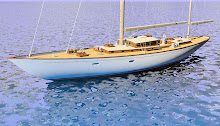
Ronnie Billings, the head electrian at the yard and the foreman for all the systems in The Ninety, hooks up wires in the junction compartment on the side of the passageway leading from the main cabin to the aft cabin.
Systems
When asked a year ago what he thought the most challenging part of The Ninety would be, Steve White replied simply, "The systems." In such a big boat, there's lots of them and they all have to work together: electrical, hydraulics, plumbing, water maker, heaters, air conditioning, lights, electronics, engine and genrators, propane to the stove and fireplace, refrigeration, the steering system, the bow thruster and anchoring systems. Most of the sailing functions are operated by hydraulics so only a few people can sail her. That all leads to miles of hoses, piping, and wires.
Here's a snap shot of what the electricians and mechanics were working on in early January.


There are two electrical control panels in the boat. the main one (top photo) is convienantly located at the base of the stairs leading down from the pilot house. The second panel (not yet installed in the lower photo) is in the captain's cabin.

Both panels back up to the machinery space so inside the space are large bundles of wires running from the panels to the junction space, where Ronnie was shown working, then onto thier destinations for the many switches, lights and motors.

The wires running from the machinery space mainly run the length of the boat in 4" square fiberglass conduits recessed into the 3" thick cored deck and into the deck beams. There are two of these conduits on each side of the boat. Many oval holes were cut in the bottom of the conduits to allow wires to be pulled out and run along beams or in cabinets to the devices they are energizing.

This week the pumps, controls and secondary filters for the water maker system were installed in the lazerette. The rudder is to the right. This is only half of this part of the system. On the other side of the boat (starboard) is an identical set.

The inlet and main filters for the water maker system were installed in the machinery space about the same time the engine was installed, months ago. Altogether the water maker system can make 1800 gallons of fresh water in 24 hours.


























